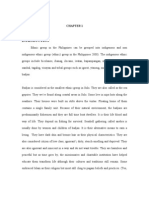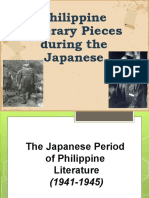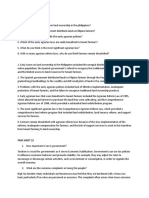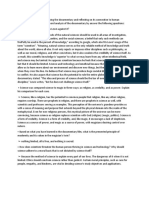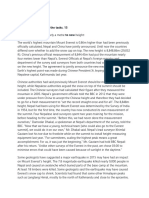Sample Template For Thesis
Sample Template For Thesis
Uploaded by
Jordan CruzCopyright:
Available Formats
Sample Template For Thesis
Sample Template For Thesis
Uploaded by
Jordan CruzOriginal Title
Copyright
Available Formats
Share this document
Did you find this document useful?
Is this content inappropriate?
Copyright:
Available Formats
Sample Template For Thesis
Sample Template For Thesis
Uploaded by
Jordan CruzCopyright:
Available Formats
OUR LADY OF FATIMA UNIVERSITY
Chapter 1 THE PROBLEM AND ITS BACKGROUND
Introduction Our children represent the continuation of our existence. Children virtually, from the moment of conception, are in the process of establishing bond with other human beings. Such bond would be reflected in the interaction between the parent and child as observed in childrearing. Child rearing is a central part of the lives and concern of the parents, majority of women, particularly mothers. In this key area of women lives, we have largely allowed expert ideas and theories to dominate public discussion and literature of child rearing but continually fail to listen to and respect what women themselves have to say on how they bring up their children. Indeed, this almost amount to failure to acknowledge the parents particularly mother of the indigenous group who indeed have views that can be expressed and listened to at all. Moreover, the specific socialization patterns and "training" for desirable childhood traits and behaviors (particularly during infancy/toddler hood and early childhood) are highly
G R A D U A T E S C H O O L
consistent with other Asian cultural groups. However, Pilipino childrearing beliefs and practices are reinforced within a traditional family
OUR LADY OF FATIMA UNIVERSITY
structure and extended family system with characteristic similarities and differences relative to other Asian cultures as well as ethnic group of the Philippines. As one of the ethnic groups of the Philipines, the Badjaos are the most seen roaming around the vicinity of Batanagas City as beggars begging for alms with their children crying in their arms and sometimes they become annoying to the public being shouted and driven away as they desperately ask for mercy. Thus, a scene catches the researchers attention to study their child rearing practices. Specifically, the Badjao inhabit the coastal area of Barangay Wawa approximately, 40 to 50 families captivated the area most of them came from Jolo, Tawitawi and Zamboanga in search for their
livelihood. Their houses are made of bamboes built at the sea area with a bamboo bridge to reach. They have no comfort rooms and bedrooms for couples privacy. Most of them are pearl vendors and pearl divers. According to a legend, they came from the shores of Johore, Indonesia, where they had already been living in clusters of houseboats. Badjao were originally of the land-based Samal group but branched off into boat dwellers as a result of their occupation. This practice might have subsequently spread to the area around Malaysia. Another theory is that the Badjao were originally boat dwellers who eventually built stilt houses near fertile fishing grounds.
G R A D U A T E S C H O O L
OUR LADY OF FATIMA UNIVERSITY
Spanish and American influence on Badjao social and cultural development has been virtually nil due to two factors: the Badjao live in the territory of the Muslim Filipinos, although they are also the least influenced by Islam; and they are itinerant travelers. The Badjao or "Sea Gypsies" inhabit the shores and waters of Sulu archipelago. They can be found today in many coastal settlements dotting the archipelago, particularly in Jolo, Tawi-Tawi and Sitangkai. Others are scattered in Davao, Surigao, Zamboanga, Basilan, Bohol, Cebu, Manila and now in Batangas City in search of livelihood. Their livelihood is totally dependent on the resources of the sea - fishes, seaweeds, shells and so forth, either for food or to sell/barter for other necessities such as clothing, materials for boat construction, and fishing equipment. A sea ritual makes the Badjaos childbirth practice somewhat peculiar. The newly born infant is thrown into the sea. Other people dive after it to rescue it. This ritual is simply an initiation into the reality of the Badjao life which is based on kinship with the sea. Their physical features are distinctively attributable to their environment and their mode of life. They have sturdy built dark brown skin and bronze hair. Their manner of walking is affected to a large extent by their crouching on boat stern while sailing or fishing.
G R A D U A T E S C H O O L
OUR LADY OF FATIMA UNIVERSITY
Regardless
of
their
cultural
orientation,
parents
play
significant role in helping their children become honorable and contributing members of society. They accomplish this by nurturing and guiding their children, engaging in problem solving with them, and modeling by "setting examples" of culturally acceptable ways of living and solving problems. This is done by adhering to the beliefs, values, and appropriate conduct accepted in their culture. Cultural context is central is parenting styles, parent-parent and parent-child interactions. This research gives consideration to child rearing practices of the indigenous group in Wawa, Batangas City with the hope that the outcome of this study will help them improve their practices in raising their children. Statement of the Problem This study aims to assess the child rearing practices of the Badjao mothers in Wawa, Batangas City. Specifically, the study sought to answers to the following questions: 1. What is the profiles of the Badjao mothers in terms of: 1.1. 1.2. 1.3. Age Educational Attainment Monthly Family Income
G R A D U A T E S C H O O L
OUR LADY OF FATIMA UNIVERSITY
1.4.
Number of Children
2. What are the child rearing practices of Badjao mothers in terms of: 2.1 physical developments 2.1 emotional developments 2.1 intellectual developments 3. What are the health practices of Badjao mothers in rearing their children in terms of 4.1 Hygiene 4.2 Healthy habits 4. What are the cultural beliefs of Badjao mothers in child rearing in terms of: 4.1 Discipline 4.2 Marriage Significance of the Study The study was conducted to determine the child rearing practices of Badjao mothers. Hopefully, findings appropriate health development program to promote and maintain good child rearing practices which could be beneficial to the following entities: To the Badjao mothers, the study may help them to furnish an idea of proper child rearing practices that will intensely benefit their children.
G R A D U A T E S C H O O L
OUR LADY OF FATIMA UNIVERSITY
The study finds usefulness to the Badjao children, as it promotes awareness of their holistic needs. Thus, promotion of optimal health for these children may be attained. To the Community this study will provide them a better insight of the role of the society to understand different cultures which form a basis for providing culture specific child rearing program; To the Local City Personnel, hopefully result and
recommendations of this study will help them improve the practices of Badjaos in their locality; To the DOH, this study will provide the fundamental data to a spent enormous amount of time to formulate program to cater the cultural minority group. To the Health Care Providers, the study could be an important source of information that could reinforce their knowledge and skills in assisting cultural minority group and as guide in planning appropriate health care plan. To the future researchers, this study will also be contributive as they would be conferred with basal data about child rearing practices of Badjao group to generate new knowledge and expand existing knowledge of their culture origin, belief and health practice which
G R A D U A T E S C H O O L
OUR LADY OF FATIMA UNIVERSITY
could be used as basis or model of their studies especially on the related field.
Scope and Limitations of the Study The study focused on the child rearing practices of Badjao mothers in Barangay Wawa, Batangas City in terms of the physical, emotional and intellectual development and health practices. The cultural beliefs among Badjao mothers regarding discipline, and marriage were also be gathered and assessed. There were 10 Badjao mothers who served as informants of this study. The researchers choose Badjao community which vitally needs health assessment as reflected in their childrearing practices. An structured questionnaire was used to illicit data which were supported with unstructured interviews to substantiate preliminary findings.
G R A D U A T E S C H O O L
OUR LADY OF FATIMA UNIVERSITY
G R A D U A T E S C H O O L
You might also like
- Should Students of Politics Seek To Be Objective and Politically NeutralDocument4 pagesShould Students of Politics Seek To Be Objective and Politically NeutralEJ Bangcong50% (2)
- Modern Filipino Family - Dinson, Red Angela O. BSN 2-BDocument1 pageModern Filipino Family - Dinson, Red Angela O. BSN 2-BRed DinsonNo ratings yet
- The Truth About Nurses, From An Ungrateful, Selfish, Arrogant SurgeonDocument4 pagesThe Truth About Nurses, From An Ungrateful, Selfish, Arrogant SurgeonJordan CruzNo ratings yet
- Description Write A Critical Analysis of The Important Historical Information Found in Gunita N Himagsikan and The Revolution by Apolinario MabiniDocument5 pagesDescription Write A Critical Analysis of The Important Historical Information Found in Gunita N Himagsikan and The Revolution by Apolinario MabiniShane Marie CortezNo ratings yet
- Position Paper de l'UEFA Sur L'interdiction Du Gazon Synthétique Par l'ECHA 19 Juillet 2019Document8 pagesPosition Paper de l'UEFA Sur L'interdiction Du Gazon Synthétique Par l'ECHA 19 Juillet 2019LeMonde.frNo ratings yet
- Chapter 1 3Document15 pagesChapter 1 3Raymund T. Baño0% (1)
- 15 Nutrition Across The Lifespan - Elderhood (Compatibility Mode)Document23 pages15 Nutrition Across The Lifespan - Elderhood (Compatibility Mode)Kathleen AngNo ratings yet
- Reaction Paper Super Typhoon YolandaDocument3 pagesReaction Paper Super Typhoon YolandaDPDA DPDONo ratings yet
- Report HistoryDocument6 pagesReport HistoryLysss EpssssNo ratings yet
- Final Assessment TaskDocument1 pageFinal Assessment TaskHERLIN HOBAYANNo ratings yet
- Bengan - Formative Assessment 2Document2 pagesBengan - Formative Assessment 2Angel Bengan100% (1)
- PrenatalDocument1 pagePrenatalJohn Patrick G. GuevarraNo ratings yet
- Activity # 6Document3 pagesActivity # 6shara santosNo ratings yet
- Position Paper Group BDocument3 pagesPosition Paper Group BUlysses John Pagente AlmoceraNo ratings yet
- Activity Report Pulot Kalat-Cdss TudloDocument3 pagesActivity Report Pulot Kalat-Cdss Tudlojestoni langgidoNo ratings yet
- St. Scholastica's College Tacloban: I. Community ProfileDocument24 pagesSt. Scholastica's College Tacloban: I. Community ProfileJosh LozadaNo ratings yet
- Philippine Literary Pieces During The Japanese PeriodDocument25 pagesPhilippine Literary Pieces During The Japanese PeriodSirjikGrenziaNo ratings yet
- )Document2 pages)heheehehe100% (1)
- University of The Philippines Diliman: An Exposure To Urban Poor Community: San Rafael, Mambugan, AntipoloDocument23 pagesUniversity of The Philippines Diliman: An Exposure To Urban Poor Community: San Rafael, Mambugan, AntipoloheraldvNo ratings yet
- Activity in RizalDocument4 pagesActivity in RizalGrenda MalauagNo ratings yet
- Philippine CartoonDocument19 pagesPhilippine CartoonAnna Teresa MendozaNo ratings yet
- ResearchDocument8 pagesResearchMcarl MatelNo ratings yet
- And Superstitions, How Was The Religious Beliefs of The Early Filipinos Depicted?Document2 pagesAnd Superstitions, How Was The Religious Beliefs of The Early Filipinos Depicted?Jawel CabanayanNo ratings yet
- Balyan in The Context of 21st Century PhilippinesDocument1 pageBalyan in The Context of 21st Century PhilippinesA. J. Santos100% (1)
- Batas Militar Reflection PaperDocument6 pagesBatas Militar Reflection PaperJumpol Phunsawat100% (1)
- Medically Significant AlgaeDocument4 pagesMedically Significant AlgaeKaren SanrilleNo ratings yet
- Module 1.1 Cordi 101Document5 pagesModule 1.1 Cordi 101JansNo ratings yet
- BSCE1E - YSIT, ERIKA KYLA - Fact or FakeDocument4 pagesBSCE1E - YSIT, ERIKA KYLA - Fact or FakeErika YsitNo ratings yet
- 3.2 Ethical Monism, Relativism and PluralismDocument3 pages3.2 Ethical Monism, Relativism and PluralismParvadha Varthini. VelmuNo ratings yet
- Public/private Domains: Gender Relations in The Central CordilleraDocument4 pagesPublic/private Domains: Gender Relations in The Central CordilleraBrylle Garnet DanielNo ratings yet
- TCWD111Document17 pagesTCWD111Gerlyn MortegaNo ratings yet
- Activity 4Document3 pagesActivity 4Hazel J. BarrientosNo ratings yet
- CW L9.MediaDocument41 pagesCW L9.MediaMayengNo ratings yet
- WorkDocument56 pagesWorkDead WalkerNo ratings yet
- M4L2 - Characters in The Novels - While Task 1Document2 pagesM4L2 - Characters in The Novels - While Task 1Cher NaNo ratings yet
- Nursing Management of AmoebiasisDocument2 pagesNursing Management of Amoebiasisjiedysy100% (1)
- Flash Fiction Sept 16Document6 pagesFlash Fiction Sept 16Manuel J. RadislaoNo ratings yet
- Reaction Paper The Physician OutlineDocument3 pagesReaction Paper The Physician OutlinePhoebe SuboNo ratings yet
- Infp Personality Type ReflectionDocument2 pagesInfp Personality Type Reflectionapi-594696350No ratings yet
- Riph - Task SheetsDocument2 pagesRiph - Task SheetsAIDAN GYLE ABROGARNo ratings yet
- Nationalmuseum DONEDocument20 pagesNationalmuseum DONEExcel BeldaNo ratings yet
- Answer The Following Questions - PEDocument1 pageAnswer The Following Questions - PERica Shaina NogaNo ratings yet
- Rizal EssayDocument1 pageRizal EssayNicoru Chan100% (1)
- PPGC211 ActivityDocument3 pagesPPGC211 ActivityMonica MangobaNo ratings yet
- Week 10 RiphDocument2 pagesWeek 10 RiphNina CervantesNo ratings yet
- NCP TapewormDocument2 pagesNCP TapewormDiana Laura LeiNo ratings yet
- Assignment 3Document3 pagesAssignment 3sunoothecutestNo ratings yet
- Reaction PaperDocument2 pagesReaction PaperMAICA JOYCE DE GUZMANNo ratings yet
- Unmasking Two Decades of Lies About Golden Rice A Critique PaperDocument3 pagesUnmasking Two Decades of Lies About Golden Rice A Critique PaperRodel Novesteras ClausNo ratings yet
- Aside From The Rise in The Mean Temperature and CO2Document2 pagesAside From The Rise in The Mean Temperature and CO2htenywgNo ratings yet
- OOP ActivityDocument1 pageOOP ActivityCooletNo ratings yet
- Worksheet Carbohydrate-Related DiseasesDocument3 pagesWorksheet Carbohydrate-Related DiseasesDaniel Angelo ArangoNo ratings yet
- FN 1reflection Paper MovieDocument3 pagesFN 1reflection Paper MovieAnne Glydel Cruzado DalaganNo ratings yet
- STSDocument3 pagesSTSCarl LarutaNo ratings yet
- Wcfe Ii 001 PDFDocument15 pagesWcfe Ii 001 PDFAnn Madrigal MauzarNo ratings yet
- Position PaperDocument3 pagesPosition PaperAbigail100% (1)
- In Partial Fulfillment To The Requirement of Literature 1: TuhogDocument9 pagesIn Partial Fulfillment To The Requirement of Literature 1: TuhogWorstWitch TalaNo ratings yet
- Jannah Marie A. Dimaporo - GEC 105 - Answer SheetDocument5 pagesJannah Marie A. Dimaporo - GEC 105 - Answer SheetsohriaameroldimaporoNo ratings yet
- Paper With PaginationDocument29 pagesPaper With PaginationCyra DonatoNo ratings yet
- Early Marrige Practices and Perception of Badjao in Inognong Bataraza PalawanDocument38 pagesEarly Marrige Practices and Perception of Badjao in Inognong Bataraza PalawanJonalyn Adjarani DiazNo ratings yet
- Badjao Case StudyDocument9 pagesBadjao Case StudyIvan Rey Porras Verdeflor100% (1)
- The Peculiar Culture of Samal Bangingi Stakeholders: Key To Improve School ConnectednessDocument15 pagesThe Peculiar Culture of Samal Bangingi Stakeholders: Key To Improve School ConnectednessPsychology and Education: A Multidisciplinary JournalNo ratings yet
- Why Doctors Should Round With NursesDocument3 pagesWhy Doctors Should Round With NursesJordan CruzNo ratings yet
- 23 Life Lessons We Learned From Grey's AnatomyDocument12 pages23 Life Lessons We Learned From Grey's AnatomyJordan CruzNo ratings yet
- 3 Detrimental Effects of Multitasking Nurses Should KnowDocument3 pages3 Detrimental Effects of Multitasking Nurses Should KnowJordan CruzNo ratings yet
- 8 Things Your Boss Won't Tell You But Wishes You KnewDocument4 pages8 Things Your Boss Won't Tell You But Wishes You KnewJordan CruzNo ratings yet
- Basic Laparotomy InstrumentsDocument10 pagesBasic Laparotomy InstrumentsJordan Cruz100% (1)
- English Tense SystemDocument26 pagesEnglish Tense SystemJordan CruzNo ratings yet
- Theories - Thesis ProposalDocument12 pagesTheories - Thesis ProposalJordan Cruz100% (2)
- Mark Scheme (Results) October 2016: Pearson Edexcel International GCE in Chemistry (WPH02) Paper 1Document15 pagesMark Scheme (Results) October 2016: Pearson Edexcel International GCE in Chemistry (WPH02) Paper 1Amar Ibna IslamNo ratings yet
- Aquatreat Selection GuideDocument3 pagesAquatreat Selection GuideMustafa KareemiNo ratings yet
- Model Set English-EDocument5 pagesModel Set English-ELava KarnaNo ratings yet
- Alchemy DR MusallamDocument71 pagesAlchemy DR MusallamCaz ZórdicNo ratings yet
- Museum Cultural CenterDocument4 pagesMuseum Cultural CenterHarsh ShahNo ratings yet
- NCP001 IsolationDocument2 pagesNCP001 IsolationJoyh LasutaNo ratings yet
- ASHSH - The Albanians and Their Territories - TextDocument249 pagesASHSH - The Albanians and Their Territories - TextGjergji80100% (1)
- .Syllabus CLI Initial & RefresherDocument21 pages.Syllabus CLI Initial & RefresherPremlata KumariNo ratings yet
- Conflict Management StylesDocument2 pagesConflict Management StylesMelissa BlackNo ratings yet
- Numerical and Optimization Techniques (NOT-2019) : AnnouncesDocument2 pagesNumerical and Optimization Techniques (NOT-2019) : AnnouncesMeera BeheraNo ratings yet
- National Standard Examination in Chemistry (Nsec) 2018-19: Indian Association of Physics TeachersDocument1 pageNational Standard Examination in Chemistry (Nsec) 2018-19: Indian Association of Physics Teacherspravat DashNo ratings yet
- Pan African Writers Association Presents: Celebrating The Life and Works of Chinua AchebeDocument12 pagesPan African Writers Association Presents: Celebrating The Life and Works of Chinua AchebeSA BooksNo ratings yet
- Clustered Energy Based Modal Assurance Criterion (CEMAC)Document4 pagesClustered Energy Based Modal Assurance Criterion (CEMAC)George PapazafeiropoulosNo ratings yet
- STMicroelectronics STM8S DISCOVERY DatasheetDocument3 pagesSTMicroelectronics STM8S DISCOVERY DatasheetPhạm Xuân HảiNo ratings yet
- Hal 15-30Document18 pagesHal 15-30Defsi SerlinNo ratings yet
- Survey of Physical Chemistry Notes - ReviewDocument3 pagesSurvey of Physical Chemistry Notes - ReviewJp2133No ratings yet
- Securing Networks With Cisco Firepower Threat DefenseDocument2 pagesSecuring Networks With Cisco Firepower Threat DefenseGopi VenkatesanNo ratings yet
- Class Notes - Design of Cantilever Retaing WallDocument49 pagesClass Notes - Design of Cantilever Retaing WallPrince A Jayswal100% (1)
- Is.13875.2.1993 0Document13 pagesIs.13875.2.1993 0JatinNo ratings yet
- Approaches and Styles of LeadershipDocument16 pagesApproaches and Styles of LeadershipMagnolia KhineNo ratings yet
- Mohali Proposed ReportDocument41 pagesMohali Proposed ReportAnas KhanNo ratings yet
- Irad Malkin - A Small Greek World. Networks in The Ancient Mediterranean (Greeks Overseas) (Retail)Document305 pagesIrad Malkin - A Small Greek World. Networks in The Ancient Mediterranean (Greeks Overseas) (Retail)rp23No ratings yet
- Vince Delmonte Bodybuilding Guide PDFDocument21 pagesVince Delmonte Bodybuilding Guide PDFAvinash Sajnani100% (1)
- Dark Reign ManualDocument56 pagesDark Reign ManualLeopoldo PastranNo ratings yet
- Problem of The Month April 2001-Weibull Beta Slopes For Ball BearingsDocument7 pagesProblem of The Month April 2001-Weibull Beta Slopes For Ball BearingsJojee MarieNo ratings yet
- Elastic Cloud Server User GuideDocument37 pagesElastic Cloud Server User GuideArielPalombaNo ratings yet
- Part List SR40Document3 pagesPart List SR40celestial equator100% (1)
- Mobile Devices Programming 2019Document159 pagesMobile Devices Programming 2019Ольга МагрицкаяNo ratings yet
- Operations Management .An Overview, Definition of Production and Operations ManagementDocument18 pagesOperations Management .An Overview, Definition of Production and Operations ManagementKumar Shiv100% (1)





